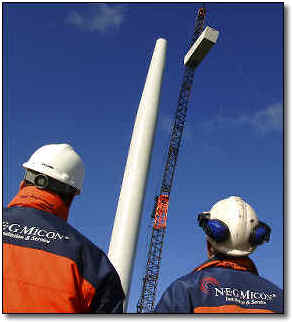
November 1, 2004
Photo: NEG Micon

|
November 1, 2004 Photo: NEG Micon |
Washington DC [RenewableEnergyAccess.com] With the extension of the federal wind energy production tax credit in September, capacity installations in 2005 look likely to beat all previous records, AWEA said in its quarterly U.S. market outlook. The previous high for new wind power capacity installations in one year was 1,696 MW in 2001. Most industry participants agree that 2005 will be a better year, with some predicting installations to exceed 2,500 MW.
"Conditions are right for next year to be a record-breaking year,"
said AWEA executive director Randall Swisher. "We will see what the U.S.
industry can do at a full-speed run for the next fourteen months. As natural gas
prices continue to demonstrate volatility, and coal prices are increasing as
well, wind power looks more attractive as a way to diversify a utility's supply
portfolio."
The slow-down in installations in 2004 that resulted from the expiration of the
production tax credit (PTC) means that many projects that have been in the
development pipeline are now ready to move forward quickly. Wind power project
developers and wind turbine and component manufacturers are now racing to lock
up supply contracts for the coming year.
At the same time, rising and volatile natural gas prices make wind energy
attractive in terms of the long-term stable energy price that the technology can
offer. Once a plant is built, it requires no fuel and produces no harmful
emissions. According to the Energy Information Administration, in the best wind
resource areas such as the plains states and the upper Midwest, wind energy is
the lowest-cost new electricity resource (with the PTC in place) when natural
gas prices rise above about $3.50 per thousand cubic feet. On the New York
Mercantile Exchange, natural gas prices topped $7 per thousand cubic feet in
October, and most experts expect it to continue in the range of $5 for the
foreseeable future.
The more wind energy capacity is installed, the more it will help to reduce the
current natural gas supply shortage in the U.S., according to AWEA. The
increasing use of natural gas to power electric generating plants is preventing
the nation from building up its storage levels during the summer. But in many
areas of the country where wind farms are generating electricity, they are
directly helping to conserve vital natural gas supplies.
"We estimate that the wind farms already in place, and those that will be
installed by the end of 2005, will be saving over 0.5 billion cubic feet (Bcf)
of natural gas per day in 2006," said Swisher. "Using conservative
growth estimates of 3,000 MW installed every two years for the next four years,
the U.S. could top 15,000 MW of installed wind power capacity by the end of
2009, which would save nearly 0.9 Bcf/day by the end of this decade."
Because the tax credit was extended relatively late in the year, AWEA expects
the U.S. to install approximately 480 MW of new capacity in 2004, well above its
previous estimate of 350 MW but far below previous strong years such as 2001
(1,696 MW) and 2003 (1,687 MW).
If installed wind power capacity were to consistently expand at a rate of 18%
per year, AWEA said, six percent of the nation's electricity could be generated
by wind power by the year 2020, resulting in over $100 billion of investment, in
addition to saving millions of cubic feet of natural gas. AWEA is continuing to
pursue policies - such as a long-term PTC extension and federal and state
renewables portfolio standards (RPS) - that will move the wind industry beyond
the boom-and-bust cycles that have resulted from short-term PTC extensions in
the past.
Information courtesy of AWEA
Please Note: RenewableEnergyAccess.com and Arizonaenergy.org do not endorse the sites behind these links. We offer them for your additional research. Following these links will open a new browser window.
Copyright © 1999 - 2004 - RenewableEnergyAccess.com
Please visit www.RenewableEnergyAccess.com for great coverage on energy today!!